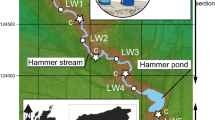Abstract
In this paper, we report the structure of the benthic invertebrate community in submerged Callitriche stagnalis Scop. stands in relation to velocity, in a Scottish river, the Blane Water. We compared the community within the macrophyte beds to that of adjacent unvegetated substrate. Callitriche stagnalis stands supported different taxa richness (no. of taxa) and abundances (no. of individuals) of benthic invertebrates than the unvegetated riffle substrate (Wilcoxon Matched-Pairs test: p<0.01, n = 10). To see if different sections of the stands supported different invertebrate communities, samples were taken from the outer, mid and root sections of the stands. The sections were separated by Detrended Correspondence Analysis (DCA) using their macroinvertebrate communities (eigenvalues: axis 1 = 0.6, axis 2 = 0.136). Abundance and taxa richness were different between the outer and mid sections, and between outer and root sections (Wilcoxon Matched-Pairs test: respectively p<0.05, p<0.01, n = 10). Community structure also differed between sections. The outer section community had a structure similar to that of an extreme environment where Simuliidae were dominant. Ephemerella ignita dominated in the mid and root sections. Differing combinations of plant structure and velocity appear to be a major factor influencing habitat structure, creating a range of stability conditions in the stands, which support the observed diversity of invertebrate assemblages present.
Similar content being viewed by others
References
Carling, P. A., 1992. The nature of the fluid-boundary layer and the selection of parameters for benthic ecology. Freshwat. Biol. 28: 273–284.
Degani, G., 1993. Relationship between current velocity, depth and the invertebrate community in a stable river system. Hydrobiologia 263: 163–172.
Doughty, C. R. & P. S. Maitland, 1994. The ecology of the River Endrick: present status and changes since 1960. Hydrobiologia 290: 131–151.
Elliot, J. M. 1977. Some Methods for the Satistical Analysis of Samples of Benthic Invertebrates. Windmere, Freshwater Biological Association.
Gray, J. S., 1987. Species-abundance patterns. In Gee, J. H. R. & P. S. Giller (eds), Organisation of Communities; Past and Present. Blackwell Scientific Publications, Oxford: 53–68.
Gregg, W. W. & F. L. Rose, 1982. The effects of aquatic macrophytes on the stream microenvironment. Aquat. Bot. 14: 309–324.
Hart, D. D., B. D. Clark & A. Jasentuliyana, 1996. Fine-scale field measurement of benthic flow environments inhabited by stream invertebrates. Limnol. Oceanogr. 41: 297–308.
Jenkins, R. A., K. R. Wade & E. Pugh, 1984. Macroinvertebrate habitat relationships in the Tefi catchment and significance to conservation. Freshwat. Biol. 14: 23–42.
Jeppesen, E., T. M. Iversen, K. Sand-Jensen & C. P. Jorgensen, 1984. Økologiske konsekvenser af reduceret vandføring i Susån., Biologiske processor og vandvalitets-forhold. Miljøstryrelsen, Copenhagen.
Jongman, R. H. G., C. J. F. Ter Braak & O. F. R. Van Tongeren, 1987. Data Analysis in Community and Landscape Ecology. Cambridge University Press, Cambridge: 299 pp.
Marshall, E. J. P. & D. F. Westlake, 1990. Water velocities around water plants in chalk streams. Folia Geobot. Phytotax. 25: 279–289.
Newbury, R. & M. Gaboury, 1993. Exploration and rehabilitation of hydraulic habitats in streams using principles of fluvial behavior. Freshwat. Biol. 29: 195–210.
Ormerod, S. J., 1988. The micro-distribution of aquatic macroinvertebrates in the Wye river system: the result of biotic or abiotic factors? Freshwat. Biol. 20: 241–247.
Sabbatini M. R. & K. J. Murphy, 1996. Response of Callitriche stagnalis Scop. and Potamogeton crispus L. to cutting, dredging and shade in English drainage channels. J. Aquat. Plant Mgmt. 33: 8–12.
Sand-Jensen, K., 1998. Influence of submerged macrophytes on sediment composition and near-bed flow in lowland streams. Freshwat. Biol. 39: 663–679.
Sand-Jensen, K. & J. R. Mebus, 1996. Fine-scale patterns of water velocity within macrophyte patches in streams. Oikos 76: 169–180.
Sand-Jensen, K. & T. V. Madsen, 1992. Patch dynamics of the stream macrophyte, Callitriche cophocarpa. Freshwat. Biol. 27: 277–282.
Sidney, S., 1956. Nonparametric statistics for the behavioural sciences. McGraw-Hill Book Company, Inc., Tokyo: 312 pp.
Smith, I. R., 1975. Turbulence in lakes and rivers. Scientific publication no. 29. Freshwater Biological Association, Ambleside, U.K: 79 pp.
Wright, J. F., 1992. Spatial and temporal occurrence of invertebrates in a chalk stream. Hydrobiol, 248: 11–30.
Vogel, S., 1994. Life in moving fluids The physical biology of flow. Princeton University Press, Princeton, New Jersey: 467 pp.
Author information
Authors and Affiliations
Rights and permissions
About this article
Cite this article
Ó Hare, M.T., Murphy, K.J. Invertebrate hydraulic microhabitat and community structure in Callitriche stagnalis Scop. patches . Hydrobiologia 415, 169–176 (1999). https://doi.org/10.1023/A:1003827000258
Issue Date:
DOI: https://doi.org/10.1023/A:1003827000258




